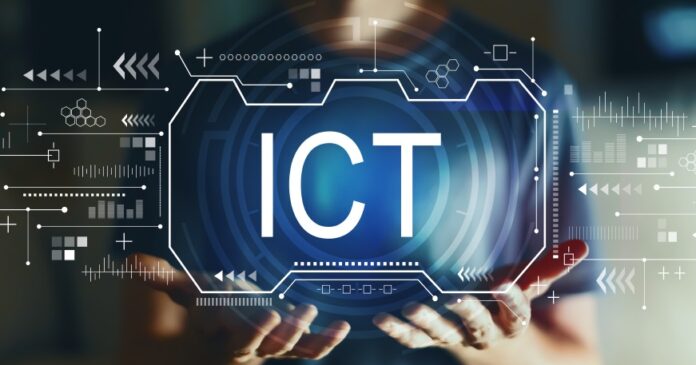Information and communications technology (ICT) is an abbreviation for information technology (IT). It emphasizes the role of unified communications and the integration of computers and telecommunications (phone lines and wireless signals), as well as the enterprise software, middleware, storage, and audiovisual components that are required to enable users to access, store, transmit, understand, and manipulate information.
ICT can also refer to the convergence of computer networks, telephone networks, and video and audio networks through a single cabling or link system. The use of a single unified system for cabling, signal distribution, and management would allow the computer network system and telephone network system to be combined economically. Any communication devices, including radio, television, cell phones, computer and network hardware, satellite systems, and so on, and the various services and tools associated with them, such as video conferencing and distance learning, fall within the broad definition of ICT. Analog technology, such as paper communication, and any medium that conveys communication are also included in ICT.
History and Evolution of ICT
The idea of mass communication was first presented by radio and television in the middle of the 20th century, and by the end of the century, the internet had established itself as a mainstream tool for communication, commerce, and entertainment. The following years saw a tremendous increase in its use, revolutionizing how people worked and communicating with one another.
| Year | Technological Advancement |
| 1837 | Morse code and telegraph |
| 1876 | Telephone |
| 1895 | Wireless telegraphy |
| 1927 | Television |
| 1947 | Transistor |
| 1951 | UNIVAC I (First commercial computer) |
| 1969 | ARPANET (Foundation of the Internet) |
| 1971 | First email |
| 1990 | World Wide Web |
| 1991 | GSM (Global System for Mobile communication) |
| 1994 | Netscape Navigator (Widely-used web browser) |
| 1998 | |
| 2001 | Commercial 3G networks |
| 2004 | |
| 2007 | iPhone |
| 2008 | Bitcoin (First blockchain-based cryptocurrency) |
| 2010 | 4G networks |
| 2016 | AlphaGo (AI system defeating world champion Go player) |
| 2020 | 5G networks |
| 2023 | Zoom (350 million daily meeting attendees) |
People can now create, access, share, and consume information easier than ever due to broadband internet and smartphones, and ICT promises even more exciting developments in the future. Faster and more dependable connectivity will be provided by 6G networks, while ChatGPT and other generative AI systems will change how people create and use information. Emerging technologies like Web3 and quantum computing will also spur the development of a wide range of new ICT tools and applications.
Information and Communication Technology Basics
Information technology (IT) and ICT are frequently used interchangeably, however when used in different contexts, the two terms can have slightly different meanings. Because IT can also refer to instructional technology in this context, the acronym ICT is used more often in education in the United States, for example. ITC, a more inclusive term that encompasses both computer technology, is used in some areas where IT only applies to enterprise computing.
ICT Infrastructure and Systems
A wide range of information, telecommunication, and support tools and services are included in information and communication technology, which together facilitate communication.
This includes:
- Supporting hardware and software for information creation, dissemination, acquisition, and storage.
- Infrastructure and electronics that allow hardware devices to communicate with one another.
- Interfaces and protocols that make it possible for various hardware and software components to communicate and exchange data without interruption.
- Tools for protecting the integrity of an ICT system and protecting sensitive data.
- Standards for protecting data while it’s in storage, during processing, and transportation.
- Governance policies for accessing, securing, processing, transmitting, and storing data.
- Workers with the skills required to design, develop, support, and maintain ICT systems.
- Information and communication technology (ICT) infrastructure includes these technologies as well as the services they provide.
Impact of ICT on Society
Many firms provide their employees the choice to work from home. Access to the network, shared files, email, and printers of the company is made possible by a secure internet connection.
Employees can communicate with the office using the company’s email system. There are plenty of additional ways to communicate. People can:
- Their mobile or smartphone to receive calls from the office
- Explore the intranet to stay informed on business developments.
- Use video conferencing to attend meetings
ICT Certifications
A candidate’s proficiency in networking topics, such as network design, setup, management, and troubleshooting, is confirmed by CompTIA Network+.
Mobile Device Security Analyst (GMOB) Verifies a candidate’s understanding of the security features of mobile devices, such as smartphones and tablets, and wireless communication technologies.
Certifications for the Certified Wireless Network Professional (CWNP) are a collection of certifications that attest to the candidates’ knowledge in many facets of wireless networking.
Candidates for the position of Microsoft Teams Voice Engineer Expert should have familiarity with PowerShell, Microsoft Teams, and telecommunications technology.
ICT and Digital Transformation
Development through digital transformation is a complicated topic that involves a wide range of enablers, such as broadband accessibility, sectoral e-strategies, legislation, and program specifically promoting digital inclusion or the growth of innovation communities. Since the COVID-19 epidemic broke out, the idea of digital transformation has gained increasing importance. Various stakeholders, including the United Nations (UN), have helped countries in their respective capacities that heavily rely on the digital component. All nations now clearly prioritize increasing access to goods and services, as well as empowering citizens, employees, and students to meet their daily needs during times of lockdown. Resilience in the digital age has increasingly depended on one’s ability to take advantage of technological advancement.




